Hard Seltzer Market
Hard Seltzer Market Analysis, By Raw Material, By Type, By Packaging, By Sales Channel, and Region - Market Insights 2025 to 2035
The Sparkling water segment is projected to grow at a CAGR of 4.0%, whereas another segment Alcohol is likely to grow at 3.9%. In terms of countries USA is projected to grow at 3.5%, followed by Japan at 4.9% and UK to grow at 4.4%.
Hard Seltzer Market Outlook (2025 to 2035)
The global hard seltzer market is expected to reach USD 24,893 million by 2035, up from USD 16,825 million in 2024. During the forecast period 2025 to 2035, the industry is projected to register at a CAGR of 3.7%.
The increased interest in low-calorie, gluten-free, and refreshing kinds of alcoholic beverages (particularly among millennials and Gen Z) has also made hard seltzers preferable. Innovation in flavor, intensive advertising, and the ease of consumption through RTD are expanding through stores and hospitality outlets worldwide.
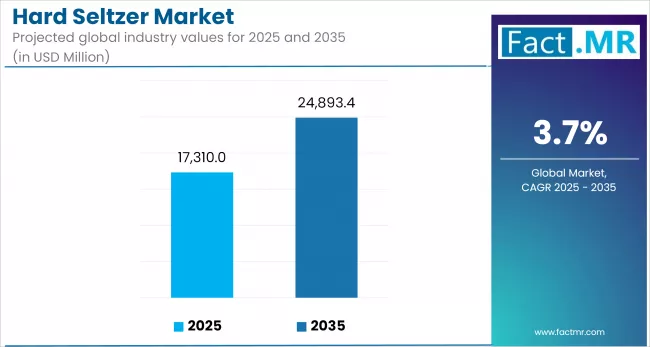
What are the drivers of Hard Seltzer Market?
One of the key factors fueling the hard seltzer market is the increasing demand for alcoholic drinks with low-calorie quantities, gluten-free options, and refreshing properties. Ever-watchful consumers, particularly millennials and Gen Z, are trending toward hard seltzers instead of traditional brands and cocktails full of sugar. These drinks offer a balanced combination of flavor, alcohol, and low carbohydrates, which aligns with current lifestyles.
Category awareness is facilitated by aggressive marketing strategies employed by key players in the market, as well as the introduction of new forthcoming products. New flavors, such as tropical fruits, botanical mixes, and seasonal blends, contribute to brands maintaining consumer interest and increasing their customer base. It is also promoted by the developed ready-to-drink (RTD) culture and ease of consumption.
The wider availability is also beneficial since the use of hard seltzers in bars, restaurants, and retail chains continues to increase. As disposable income has increased and the price of alcoholic drinks across most markets has increased, the segment has been growing steadily with new entrants as well as regular buyers, resulting in constant market growth.
What are the regional trends of Hard Seltzer Market?
North America is the leader in the world market of hard seltzer because of early adoption and the success of such brands as White Claw and truly were observed in the United States. The USA market has a developed RTD ecosystem, a social culture of drinking and confident retailer support, thus attracting the global players as the trend epicenter.
The market is picking up in Europe, especially in Britain, Germany, and the Nordic states. Here, consumers are seeking higher-quality and healthier alternatives to alcohol. Breweries and beverage companies based in Europe are coming into the market with local flavor modification and environmentally aware packaging.
The Asia-Pacific region boasts solid prospects due to the growth of middle-class citizens, urbanization, and shifting consumption patterns of alcohol. Japan and Australia and South Korea are also starting to grow in popularity due to their novelty and wellness-oriented products among urban crowds especially among youth.
What are the challenges and restraining factors of Hard Seltzer Market?
There are a number of challenges surrounding the hard seltzer market even though it is rapidly expanding. Consuming an already saturated market in mature markets such as North America is one of the obstacles. New brands have struck a heavy competition, price wars, reduction in the product life-cycle and attaining long term brand loyalty almost impossible.
The other barrier is regulatory and labeling ambiguity. Hard seltzers in different countries have been in limbo when categorized among beer, spirits, and soft drinks and this has affected marketing, taxation, and marketing shelves. These obstacles make it hard and unfriendly to market entry new players and cut global scalability.
Consumer preferences are risky to change. Although hard seltzer drinks are now in line with wellness trends, they could decrease in popularity due to a paradigm shift toward functional/non-alcoholic drinks. There is a challenge in retaining a stable taste and quality across the product lines while being innovative with flavors.
Issues of environmental single-use packaging and carbon footprint production are also taking center stage. To meet consumer expectations and comply with regulatory oversight, brands must invest in sustainable activities.
Country-Wise Outlook
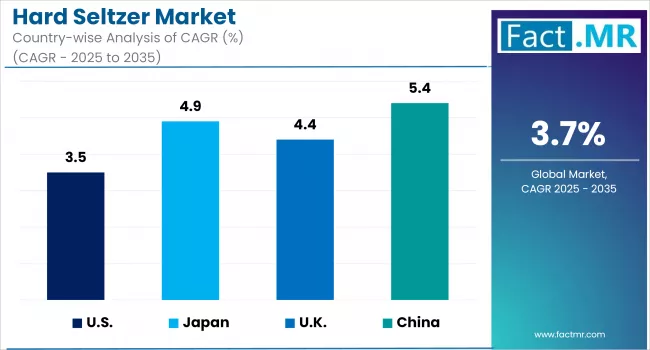
Premium & health drive USA hard seltzer dominance
The USA dominates the worldwide hard seltzer market driven by its consumption pattern of millennials who are choosing to move on to low-calorie, gluten-free and flavored alcoholic products. The concept of health-oriented consumption and the significant shift in strategy by key players in the alcohol market drives the explosive growth of the market.
The element of innovation in brands is making use of zero-sugar compositions, natural fruit extracts, and even adaptogen-enriched versions. The US regulatory situation favors innovation through permissive regulation, particularly with regard to flavored malt drinks. E-commerce avenues and RTD types of packaging have also enhanced reach. The mass distribution via distribution deals with retailers such as Walmart and Target exposes hard seltzers to a large market. Brand loyalty and seasonality are still a problem, and this is driving constant product line refresh.
Japan’s hard seltzer growth anchored in functional alcohol trends
Japan has become a rising star in hard seltzer because city dwellers are increasingly concerned with healthier, low-ABV alcohol drinks. The already established culture of chu-hi (shochu highball) has provided the foundation on which flavored carbonated alcohol can build, allowing for an easy shift to varieties of hard seltzer.
Domestic powerhouses Suntory and Asahi are introducing craft-style seltzers using local tastes, including yuzu and ume, along with a preference for quality and functional ingredients. This is an essential convenience store in product trial and uptake. Strict labeling standards regarding alcohol content, functional claims are establishing a distinctive pattern of innovation.
UK taps into seltzer with sustainability and clean label focus
United Kingdom is the most rapidly growing hard seltzer market in Europe due to the increasing demand for more sustainable, vegan products and less calorie beverages. Seltzers are on the rise as young professionals substitute it with traditional beers and ciders as a way of socializing after work and at weekends.
Bottled spirits brands such as DRTY and Bodega Bay and multinational brands such as White Claw are focusing on recyclability, clean labels, and carbon neutrality. High-end retail spaces and internet subscriptions are becoming common. The HFSS (High Fat, Sugar, and Salt) advertising ban in the UK is just another aspect in favor of hard seltzers as opposed to regular RTDs.
Category-Wise Analysis
Sparkling water emerges as the foundation for crisp, refreshing hard seltzers
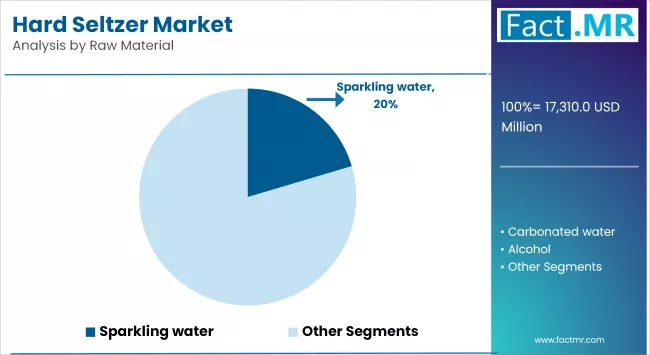
Hard seltzers predominantly use sparkling water as their primary raw material, as they utilize high-quality carbonated water as their primary liquid, making the liquid more drinkable and flavorful. It enables brands to produce a light, effervescent mouthfeel that is attractive to both health-conscious and casual drinkers. The use of sparkling water also aligns with the growing market concern over low-sugar, low-calorie formulas, making it a product of choice for current consumers of alcoholic beverages.
Low-ABV seltzers (<5%) drive mass appeal with sessional drinking options
Alcohol by volume (ABV) of hard seltzers below 5 percent is shaping the mainstream of the market. The drinks are aimed at wellness-conscious people who love moderation and do not want to compromise on enjoyment. It is also easier to avoid the heavy regulations imposed in certain markets because of the low levels of alcohol in such brands. This kind balances taste and functionality, and they tend to be made with sugar-based and fermented alcohol fruit to keep the profile lighter.
Glass bottles reintroduce premium appeal in a can-dominated seltzer market
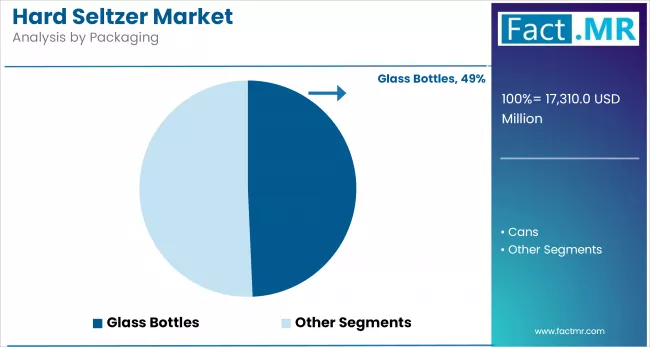
Even though cans are still the standard of hard seltzers, glass bottles can create a niche and establish themselves as the premium and sustainable product in the hard seltzer world. The decision to use this type of packaging will improve shelf appeal, attract environmentally conscious, and brand loyal consumers, especially on premise business areas such as bars and restaurants. Glass is also preferable to maintaining or prolonging its carbonation and flavor, which improves with longevity, and once again would support a small-batch or craft-positioned brand of hard seltzer.
Competitive Analysis
High competition and active innovation are the characteristics of the hard seltzer market, as well as increased attention of companies to topics of flavor toleration, alcohol level change, sustainability packaging in order to gain customer preference. Traditional market structures are still being disrupted by new players and regional players through fast-moving and opportunities such as new health-conscious millennials with low-calorie formulations, gluten-free and organic products.
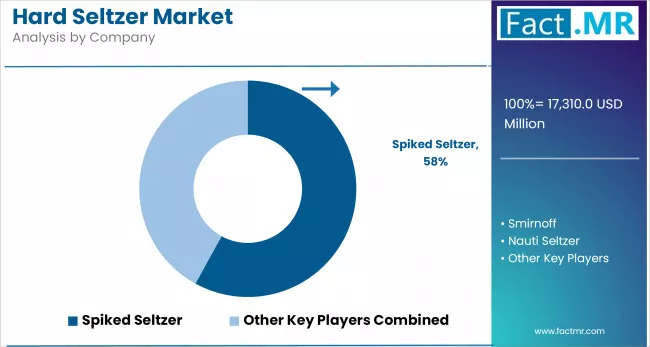
Retailer edged out entry in the business of retailer brands, which has contributed to the shrinking of the market share by well-established brands offering cheaper alternatives. The collaborations across category and in particular with functional beverage makers that include adaptogens or CBD are also changing the competitive environment.
Targeted as a strategic tool of creating urgency and brand excitement are seasonal launches and limited-edition SKUs. Competitive advantage more and more depends on responsive supply chain, quick turnaround of R&D and data-driven marketing. Environmental-friendly consumers also prefer companies that have adopted an approach of sustainability and transparency in terms of ingredient sourcing, and yet market segmentation and specialization is intensifying. In sum, being flexible and authentic in the brand position is rewarded on the market and companies are denied to rest on their laurels in the value propositions.
Key players in the market are Spiked Seltzer, Smirnoff, Nauti Seltzer, White Claw, Oskar Blues, Truly, Oskar Blues Brewery, Henry’s, Pura Still, Polar, Bon & Viv, Nutrl, Bud Light Seltzer, Corona Seltzer, Vizzy Hard Seltzer, and other players.
Recent Development
- In May 2025, High Noon, a vodka-based hard seltzer launched by California wine giant Gallo in 2019, has become the top-selling USA spirit by volume, surpassing stalwarts like Tito's. The brand expanded to 14 flavors and recently launched vodka iced teas and tequila seltzers, producing nearly 25 million cases annually. Strategic alignments like becoming the official spirits-based seltzer of the PGA of America and other influencer-led campaigns have widened its appeal.
- In March 2025, Kraft Heinz is making its first foray into the alcohol market with the launch of vodka seltzers infused with Crystal Light flavors. Initially available in lemonade and wild strawberry in select northeast USA supermarkets, the company plans a broader expansion next year. This move comes as Kraft Heinz faces challenges with declining sales of its traditional food products and is part of a broader effort to modernize its offerings and attract younger consumers.
Fact.MR has provided detailed information about the price points of key manufacturers in the Hard Seltzer Market, positioned across regions, including sales growth, production capacity, and speculative technological expansion, as recently published in the report.
Methodology and Industry Tracking Approach
The research study of Hard Seltzer market was carried out by Fact.MR in 2025, and it consulted more than 4,800 verified professionals based in 22 countries. Respondents worked in areas covering formulation of artisanal beverages, distribution of low-ABV drinks, designing of lightweight aluminum cans and export compliance among flavored alcoholic drinks. Each of the countries that participated in the research provisionally used the cooperation of at least 85 professionals who dedicated their time to fermentation innovation, the high-level branding of RTD, as well as the evaluation of sensory quality.
The research witnessed significant changes over the period from June 2024 to May 2025. The increase of infusion-based approach to the botanicals, the fast expansion of limited-edition seasonal hard seltzers, and the growth of industry requirements toward transparent ingredients traceability and accurate labeling of flavors, as well as carbon-neutral production. The regional demands were clamoring with flavor-forward components, low-calorie fine blending, and creative barrel-laden finishing with barrels once dedicated to ros wine, aged rum, or citrus-flavored spirit execution.
Fact.MR had been on the monitor of the RTD alcoholic segment until 2018, with reports on carbonation efficiency, aroma retention schedules as well as raw materials sourcing in the global supply networks. The experience in the analysis will follow the extremity of the movement to the market on a clear brand narrative that discloses the extent of the sustainable packs and performance innovation. The dynamic identity of the hard seltzer category is now consistent with its premium meaning that is established on authentic craftsmanship, artisanal purity, and value of sustainable production values.
Segmentation of Hard Seltzer Market
-
By Raw Material :
- Sparkling water
- Carbonated water
- Alcohol
- Fruit flavors
- Others
-
By Type :
- ABV Less than 5%
- ABV More than 5%
-
By Packaging :
- Glass Bottles
- Cans
-
By Sales Channel :
- At Home
- Supermarket
- Convenience Store
- Out of Home
- Restaurants
- Bars
- At Home
-
By Region :
- North America
- Latin America
- Western Europe
- Eastern Europe
- East Asia
- South Asia & Pacific
- Middle East & Africa
Table of Content
- Executive Summary
- Industry Introduction, including Taxonomy and Market Definition
- Trends and Success Factors, including Macro-economic Factors, Market Dynamics, and Recent Industry Developments
- Global Market Demand Analysis 2020 to 2024 and Forecast 2025 to 2035, including Historical Analysis and Future Projections
- Global Market Analysis 2020 to 2024 and Forecast 2025 to 2035
- Raw Material
- Type
- Packaging
- Sales Channel
- Global Market Analysis 2020 to 2024 and Forecast 2025 to 2035, By Raw Material
- Sparkling water
- Carbonated water
- Alcohol
- Fruit flavors
- Others
- Global Market Analysis 2020 to 2024 and Forecast 2025 to 2035, By Type
- ABV Less than 5%
- ABV More than 5%
- Global Market Analysis 2020 to 2024 and Forecast 2025 to 2035, By Packaging
- Glass Bottles
- Cans
- Global Market Analysis 2020 to 2024 and Forecast 2025 to 2035, By Sales Channel
- At Home
- Supermarket
- Convenience Store
- Out of Home
- Restaurants
- Bars
- At Home
- Global Market Analysis 2020 to 2024 and Forecast 2025 to 2035, By Region
- North America
- Latin America
- Western Europe
- South Asia & Pacific
- East Asia
- Eastern Europe
- Middle East & Africa
- North America Sales Analysis 2020 to 2024 and Forecast 2025 to 2035, by Key Segments and Countries
- Latin America Sales Analysis 2020 to 2024 and Forecast 2025 to 2035, by Key Segments and Countries
- Western Europe Sales Analysis 2020 to 2024 and Forecast 2025 to 2035, by Key Segments and Countries
- South Asia & Pacific Sales Analysis 2020 to 2024 and Forecast 2025 to 2035, by Key Segments and Countries
- East Asia Sales Analysis 2020 to 2024 and Forecast 2025 to 2035, by Key Segments and Countries
- Eastern Europe Sales Analysis 2020 to 2024 and Forecast 2025 to 2035, by Key Segments and Countries
- Middle East & Africa Sales Analysis 2020 to 2024 and Forecast 2025 to 2035, by Key Segments and Countries
- Sales Forecast to 2035 by Raw Material, Type, Packaging, and Sales Channel for 30 Countries
- Competitive Assessment, Company Share Analysis by Key Players, and Competition Dashboard
- Company Profile
- Spiked Seltzer
- Smirnoff
- Nauti Seltzer
- White Claw
- Oskar Blues
- Truly
- Oskar Blues Brewery
- Henry’s
- Pura Still
- Polar
List Of Table
- Table 1: Global Market Units Forecast by Region, 2020 to 2035
- Table 2: Global Market Units Forecast by Raw Material, 2020 to 2035
- Table 3: Global Market Units Forecast by Type, 2020 to 2035
- Table 4: Global Market Units Forecast by Packaging, 2020 to 2035
- Table 5: Global Market Units Forecast by Sales Channel, 2020 to 2035
- Table 6: North America Market Units Forecast by Country, 2020 to 2035
- Table 7: North America Market Units Forecast by Raw Material, 2020 to 2035
- Table 8: North America Market Units Forecast by Type, 2020 to 2035
- Table 9: North America Market Units Forecast by Packaging, 2020 to 2035
- Table 10: North America Market Units Forecast by Sales Channel, 2020 to 2035
- Table 11: Latin America Market Units Forecast by Country, 2020 to 2035
- Table 12: Latin America Market Units Forecast by Raw Material, 2020 to 2035
- Table 13: Latin America Market Units Forecast by Type, 2020 to 2035
- Table 14: Latin America Market Units Forecast by Packaging, 2020 to 2035
- Table 15: Latin America Market Units Forecast by Sales Channel, 2020 to 2035
- Table 16: Western Europe Market Units Forecast by Country, 2020 to 2035
- Table 17: Western Europe Market Units Forecast by Raw Material, 2020 to 2035
- Table 18: Western Europe Market Units Forecast by Type, 2020 to 2035
- Table 19: Western Europe Market Units Forecast by Packaging, 2020 to 2035
- Table 20: Western Europe Market Units Forecast by Sales Channel, 2020 to 2035
- Table 21: South Asia & Pacific Market Units Forecast by Country, 2020 to 2035
- Table 22: South Asia & Pacific Market Units Forecast by Raw Material, 2020 to 2035
- Table 23: South Asia & Pacific Market Units Forecast by Type, 2020 to 2035
- Table 24: South Asia & Pacific Market Units Forecast by Packaging, 2020 to 2035
- Table 25: South Asia & Pacific Market Units Forecast by Sales Channel, 2020 to 2035
- Table 26: East Asia Market Units Forecast by Country, 2020 to 2035
- Table 27: East Asia Market Units Forecast by Raw Material, 2020 to 2035
- Table 28: East Asia Market Units Forecast by Type, 2020 to 2035
- Table 29: East Asia Market Units Forecast by Packaging, 2020 to 2035
- Table 30: East Asia Market Units Forecast by Sales Channel, 2020 to 2035
- Table 31: Eastern Europe Market Units Forecast by Country, 2020 to 2035
- Table 32: Eastern Europe Market Units Forecast by Raw Material, 2020 to 2035
- Table 33: Eastern Europe Market Units Forecast by Type, 2020 to 2035
- Table 34: Eastern Europe Market Units Forecast by Packaging, 2020 to 2035
- Table 35: Eastern Europe Market Units Forecast by Sales Channel, 2020 to 2035
- Table 36: Middle East & Africa Market Units Forecast by Country, 2020 to 2035
- Table 37: Middle East & Africa Market Units Forecast by Raw Material, 2020 to 2035
- Table 38: Middle East & Africa Market Units Forecast by Type, 2020 to 2035
- Table 39: Middle East & Africa Market Units Forecast by Packaging, 2020 to 2035
- Table 40: Middle East & Africa Market Units Forecast by Sales Channel, 2020 to 2035
List Of Figures
- Figure 1: Global Market Value Share (%), Growth Rate (Y-o-Y), and Units Projection by Raw Material, 2020 to 2035
- Figure 2: Global Market Value Share (%), Growth Rate (Y-o-Y), and Units Projection by Type, 2020 to 2035
- Figure 3: Global Market Value Share (%), Growth Rate (Y-o-Y), and Units Projection by Packaging, 2020 to 2035
- Figure 4: Global Market Value Share (%), Growth Rate (Y-o-Y), and Units Projection by Sales Channel, 2020 to 2035
- Figure 5: Global Market Value Share (%), Growth Rate (Y-o-Y), and Units Projection by Region, 2020 to 2035
- Figure 6: North America Market Value Share (%), Growth Rate (Y-o-Y), and Units Projection by Raw Material, 2020 to 2035
- Figure 7: North America Market Value Share (%), Growth Rate (Y-o-Y), and Units Projection by Type, 2020 to 2035
- Figure 8: North America Market Value Share (%), Growth Rate (Y-o-Y), and Units Projection by Packaging, 2020 to 2035
- Figure 9: North America Market Value Share (%), Growth Rate (Y-o-Y), and Units Projection by Sales Channel, 2020 to 2035
- Figure 10: North America Market Value Share (%), Growth Rate (Y-o-Y), and Units Projection by Country, 2020 to 2035
- Figure 11: Latin America Market Value Share (%), Growth Rate (Y-o-Y), and Units Projection by Raw Material, 2020 to 2035
- Figure 12: Latin America Market Value Share (%), Growth Rate (Y-o-Y), and Units Projection by Type, 2020 to 2035
- Figure 13: Latin America Market Value Share (%), Growth Rate (Y-o-Y), and Units Projection by Packaging, 2020 to 2035
- Figure 14: Latin America Market Value Share (%), Growth Rate (Y-o-Y), and Units Projection by Sales Channel, 2020 to 2035
- Figure 15: Latin America Market Value Share (%), Growth Rate (Y-o-Y), and Units Projection by Country, 2020 to 2035
- Figure 16: Western Europe Market Value Share (%), Growth Rate (Y-o-Y), and Units Projection by Raw Material, 2020 to 2035
- Figure 17: Western Europe Market Value Share (%), Growth Rate (Y-o-Y), and Units Projection by Type, 2020 to 2035
- Figure 18: Western Europe Market Value Share (%), Growth Rate (Y-o-Y), and Units Projection by Packaging, 2020 to 2035
- Figure 19: Western Europe Market Value Share (%), Growth Rate (Y-o-Y), and Units Projection by Sales Channel, 2020 to 2035
- Figure 20: Western Europe Market Value Share (%), Growth Rate (Y-o-Y), and Units Projection by Country, 2020 to 2035
- Figure 21: South Asia & Pacific Market Value Share (%), Growth Rate (Y-o-Y), and Units Projection by Raw Material, 2020 to 2035
- Figure 22: South Asia & Pacific Market Value Share (%), Growth Rate (Y-o-Y), and Units Projection by Type, 2020 to 2035
- Figure 23: South Asia & Pacific Market Value Share (%), Growth Rate (Y-o-Y), and Units Projection by Packaging, 2020 to 2035
- Figure 24: South Asia & Pacific Market Value Share (%), Growth Rate (Y-o-Y), and Units Projection by Sales Channel, 2020 to 2035
- Figure 25: South Asia & Pacific Market Value Share (%), Growth Rate (Y-o-Y), and Units Projection by Country, 2020 to 2035
- Figure 26: East Asia Market Value Share (%), Growth Rate (Y-o-Y), and Units Projection by Raw Material, 2020 to 2035
- Figure 27: East Asia Market Value Share (%), Growth Rate (Y-o-Y), and Units Projection by Type, 2020 to 2035
- Figure 28: East Asia Market Value Share (%), Growth Rate (Y-o-Y), and Units Projection by Packaging, 2020 to 2035
- Figure 29: East Asia Market Value Share (%), Growth Rate (Y-o-Y), and Units Projection by Sales Channel, 2020 to 2035
- Figure 30: East Asia Market Value Share (%), Growth Rate (Y-o-Y), and Units Projection by Country, 2020 to 2035
- Figure 31: Eastern Europe Market Value Share (%), Growth Rate (Y-o-Y), and Units Projection by Raw Material, 2020 to 2035
- Figure 32: Eastern Europe Market Value Share (%), Growth Rate (Y-o-Y), and Units Projection by Type, 2020 to 2035
- Figure 33: Eastern Europe Market Value Share (%), Growth Rate (Y-o-Y), and Units Projection by Packaging, 2020 to 2035
- Figure 34: Eastern Europe Market Value Share (%), Growth Rate (Y-o-Y), and Units Projection by Sales Channel, 2020 to 2035
- Figure 35: Eastern Europe Market Value Share (%), Growth Rate (Y-o-Y), and Units Projection by Country, 2020 to 2035
- Figure 36: Middle East & Africa Market Value Share (%), Growth Rate (Y-o-Y), and Units Projection by Raw Material, 2020 to 2035
- Figure 37: Middle East & Africa Market Value Share (%), Growth Rate (Y-o-Y), and Units Projection by Type, 2020 to 2035
- Figure 38: Middle East & Africa Market Value Share (%), Growth Rate (Y-o-Y), and Units Projection by Packaging, 2020 to 2035
- Figure 39: Middle East & Africa Market Value Share (%), Growth Rate (Y-o-Y), and Units Projection by Sales Channel, 2020 to 2035
- Figure 40: Middle East & Africa Market Value Share (%), Growth Rate (Y-o-Y), and Units Projection by Country, 2020 to 2035
- FAQs -
What was the global Hard seltzer market size reported by Fact.MR for 2025?
The Global Hard seltzer market was valued at USD 17,310 Million in 2025.
Who are the major players operating in the hard seltzer market?
Prominent players in the market are Spiked Seltzer, Smirnoff, Nauti Seltzer, White Claw, Oskar Blues, Truly, Oskar Blues Brewery, Henry’s, Pura Still, Polar, Bon & Viv, Nutrl, Bud Light Seltzer, Corona Seltzer, and Vizzy Hard Seltzer.
What is the Estimated Valuation of the hard seltzer market in 2035?
The market is expected to reach a valuation of USD 24,893 Million in 2035.
What value CAGR did the Hard seltzer market exhibit over the last five years?
The historic growth rate of the Hard seltzer market was 2.8% from 2020 to 2024.